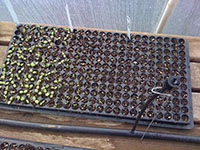Growing for Market in partnership with Johnny's Selected Seeds has created a library of expert information about growing and selling vegetables and flowers. Links in the article will take you to johnnyseeds.com.
Subscribe to Growing for Market for more great ideas about growing and marketing!
For more topics in the series, click on Market Farming Basics in the left column.

![]()
Foliar Feeding
As young plants re-establish in the field or garden, they often have trouble taking up the nutrients they need from thesoil. Soil conditions such as high pH, excess moisture, and cold temperatures also can make nutrients unavailable to plant roots. This is often exhibited by purpling or yellowing of the lower leaves on plants. When this occurs, foliar feeding spraying liquid fertilizer on the plants' leaves and stems may provide needed nutrients for a short period of time until the roots can resume nutrient uptake.

Foliar feeding has many other reported applications: It can be used at flowering to increase fruit set. It is believed to make plants less sensitive to frost. Foliar sprays of compost tea help prevent plant diseases. And certain nutrient-related problems can be addressed by foliar sprays of the specific nutrient, such as calcium to prevent blossom end rot on tomatoes.
The major pathway for nutrient uptake in fruits and vegetables is by the roots, so do not expect foliar feeding to supply all the nutrients needed. Remember the motto of sustainable farming is "Feed the soil, not the plant." Foliar feeding is a temporary measure for special situations, and should not replace cover cropping and soil amendments as recommended by regular soil tests.
Foliar fertilizers should be diluted so as not to burn the leaves. Fish emulsion and seaweed are the preferred foliar fertilizers for vegetables. Not only are they easy to dilute, they also contain micronutrients that are essential to plant health.
Apply a foliar fertilizer by a fine mist sprayer or nozzle. Spray to the point of run-off.
Mix the foliar feed solution in a clean sprayer. When you're done, run plenty of clean water through the sprayer to prevent clogging.
Foliar feed on a cloudy day (but not if rain is imminent), early in the morning or late in the afternoon, to avoid sun damage to the wet leaves. Do not foliar feed on hot days, as the heat can cause plants' stomata to close and prevent absorption of the nutrients.
If in doubt about the success of foliar feeding, use a refractometer. Take a sample before foliar feeding, and then a few minutes after foliar feeding. If the Brix has increased, the plant has taken up the nutrients.
Water-soluble fertilizers can be applied through an irrigation system, a process known as fertigation. Not only does fertigation save time, it also ensures a more even and effective distribution of fertilizer directly to the plants' roots. Like foliar feeding, fertigation can be used to quickly fortify plants that are under stress and unable to take up nutrients from the soil.
Fertigation requires a system for injecting the fertilizer into irrigation water at the correct rate. The simplest solution is to use a Syphonject, which attaches between a garden hose and faucet and has a suction tube that is placed in a bucket of liquid fertilizer solution. The Syphonject draws up fertilizer and mixes it with water at a rate of 16:1. It is suitable for watering with a hose, but not with drip irrigation. For drip irrigation, a fertilizer injector is required.
Visit Johnny's Selected Seeds for more free information about growing produce, herbs, cover crops and flowers.
Subscribe to Growing for Market for the latest news and ideas.
Reprinted from JSS Advantage May 2010



 Insect pollination is essential to many vegetable and fruit crops, including tomatoes, squash, pumpkins, watermelons, blueberries, blackberries, apples, almonds, and many others. In the case of watermelons, there will be no fruit without pollination. Some vegetables don't require pollination to set fruit, but pollination by bees will result in larger and more abundant fruits. Nearly 75% of the flowering plants on Earth rely on pollinators to set seed or fruit, as well as one-third of our food crops, and most pollination is performed by honey bees, native bees, and other insects.
Insect pollination is essential to many vegetable and fruit crops, including tomatoes, squash, pumpkins, watermelons, blueberries, blackberries, apples, almonds, and many others. In the case of watermelons, there will be no fruit without pollination. Some vegetables don't require pollination to set fruit, but pollination by bees will result in larger and more abundant fruits. Nearly 75% of the flowering plants on Earth rely on pollinators to set seed or fruit, as well as one-third of our food crops, and most pollination is performed by honey bees, native bees, and other insects. 



